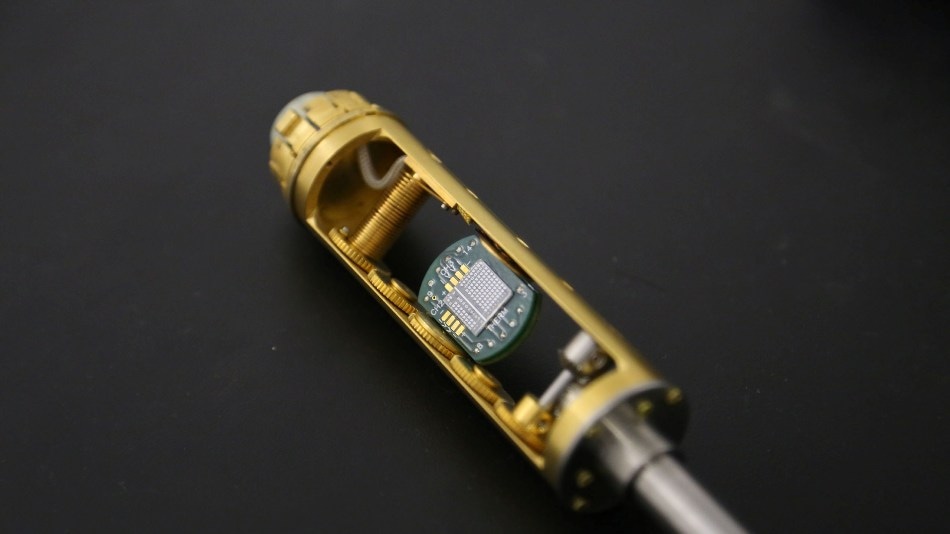Dec 2 2019
Modern computer memory performs information encoding by switching magnetic bits inside devices.
 Future magnon torque-based devices such as this could allow for faster electronic gadgets that require less power and do not overheat. Image Credit: National University of Singapore.
Future magnon torque-based devices such as this could allow for faster electronic gadgets that require less power and do not overheat. Image Credit: National University of Singapore.
An innovative study by scientists from NUS Electrical and Computer Engineering has now discovered a new efficient technique, which involves making use of “spin waves” to switch magnetization at ambient temperature to realize spin memory and logic devices that are more energy-efficient.
The efficiency of conventional electronic chips is affected by considerable “Joule heat,” which is caused by the high temperatures produced when electric current flows. It occurs due to fast motion and frequent collision of moving charges within the devices. This severe problem leads to substantial power dissipation and hampers the processing speed of the chip and restricts the number of chips that can be integrated into appliances.
We always encounter such problems and inconveniences when using our phones, computers and other electronic devices. We often find that these devices are becoming ‘hot’ and ‘slow’, moreover, we need to charge them frequently and have to bring another portable charger sometimes.
Yang Hyunsoo, Study Team Leader and Professor, Department of Electrical and Computer Engineering, National University of Singapore
Therefore, instead of utilizing standard electron injection techniques used in conventional electronics, Prof. Yang’s team innovatively used “spin waves” to switch magnetization. Spin waves are disturbances that propagate in the ordering of magnetic materials. From the quasiparticle perspective, spin waves are called “magnons.”
The researchers developed a bilayer system, including a topological insulator spin source and an antiferromagnetic magnon transport channel. For the first time in the world, they were successful in demonstrating switching of magnetization induced by spin waves in the neighboring ferromagnetic layer with high efficiency at ambient temperature.
The new switching method based on spin waves can eliminate moving charges. Thus, considerably less Joule heat and power dissipation would be anticipated for devices. Further development of spin wave-based switching could pave a new way to make energy-efficient chips.
The study outcomes were reported in the Science journal on November 29th, 2019.
Spin Waves and Magnon Torque
The spin waves (magnons) can deliver spin information even in insulators without involving moving charges. This unique property potentially allows longer spin propagation but with lower dissipation compared to electron spins.
Dr Wang Yi, Study First Author, Department of Electrical and Computer Engineering, National University of Singapore
“Then we can control the magnetisation if we transfer the spin information from the magnons to the local magnetisation, which can be understood as ‘magnon torques’,” noted Dr Wang. Quite similar to a linear force, which is a pull or a push, a torque can be considered as a twist to an object. “Hence, this new way to manipulate the magnetisation can be used for future data memory and logic devices,” he added.
Potential Applications and Next Steps
“Our work first shows that the magnon torque is sufficient to switch the magnetisation at room temperature. Even the efficiency of the magnon torque is comparable with previously pursued electrical spin torque efficiency. We believe it can be substantially enhanced by engineering devices further, so that the magnon torque will become more energy efficient,” stated Prof. Yang.
We know that the electrical spin torque has opened the era for spintronic device applications such as magnetic random access memories (MRAMs). We believe our report of the new magnon torque scheme for magnetisation switching is a game-changing idea in spintronics. It will invigorate not only a new research area in magnonics, but also practical devices operated by magnons.
Dr Wang Yi, Study First Author, Department of Electrical and Computer Engineering, National University of Singapore
The next step of the researchers will be to further advance the efficiency of magnon torques and investigate all magnon devices without any electrical components. Moreover, the operation frequency of spin waves is in the terahertz range.
Terahertz devices have the ability to transmit data at considerably higher speeds than possible now. “Therefore, magnon torque based devices will allow the implementation of ultrahigh speed applications in the future,” stated Prof. Yang.